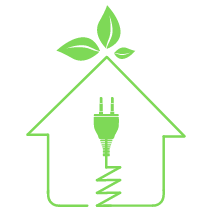
Learn more about the logistics in bringing clean energy to Naperville
WHAT’S THE ISSUE WITH COAL IN NAPERVILLE?
WHO IS IMEA? WHY DOES NAPERVILLE PURCHASE COAL-POWERED ENERGY?
Electricity bought from Naperville Electric is actually purchased from a power provider because Naperville does not generate its own electricity for its distribution system. Naperville Electric is a both a co-owner and a customer of the Illinois Municipal Electric Agency (IMEA). IMEA consists of 32 member municipal electric utilities[1] who are both co-owners and customers of IMEA.
To meet the needs of its members, IMEA acquires electricity from various sources, but IMEA has reported that only 11% comes from renewable energy. The primary sources are two coal-fired power plants partially owned by IMEA[2]. IMEA owns 15.17% of Prairie State Generating Company, which generates electricity at the mouth of a coal mine near Marissa, Illinois. IMEA also owns 12.12% of Trimble County 1 and 2 in Kentucky, which also generates electricity by burning coal.
Generating the power purchased by Naperville to sell to its customers emits more than two billion pounds of CO2 greenhouse gasses[3] every year plus mercury and other toxins. These emissions accelerate climate change and harm people and the environment. However, Naperville does not feel the harm caused by the coal plants because they are hundreds of miles away from the Naperville community. The Prairie State and Trimble County coal plants, which Naperville purchases power from, collectively emit more than 40 billion pounds of CO2 every year[4] – the equivalent of burning 2 billion gallons of gas[5].
Naperville buys electricity from IMEA pursuant to a Power Sales Contract that it signed in 2007. Although Naperville knew when it signed the contract that IMEA would be adding coal resources to meet Naperville’s needs, that was 14 years ago when renewable energy was less available and more expensive. It is time for Naperville to revisit that decision and join other utilities in the switch to clean energy. Switching to clean energy will allow Naperville to achieve its “high-level energy goals: advance renewable energy, enact policies that support clean energy and engage the community in clean energy practices”[6].
[1] http://imea.org/AboutIMEA.aspx
[2] Power Supply pie chart on p.7 at http://imea.org/IMEA%20Annual%20Reports/2019AnnualReport.pdf
[3] 1,335,884 MWh x 1800 lbs CO2 (73% coal and 17% gas) = 2,404,591,200 lbs of CO2, equivalent to the amount emitted every year by 237,109 cars (https://www.epa.gov/greenvehicles/greenhouse-gas-emissions-typical-passenger-vehicle)
[4] https://www.eia.gov/electricity/data/emissions/ (Prairie State is the largest power plant emitter of CO2 in IL)
[5] https://www.fueleconomy.gov/feg/contentIncludes/co2_inc.htm
[6] https://www.naperville.il.us/services/electric-utility/powering-our-community-for-the-future/solar-panel-guidelines/
WHEN WILL NAPERVILLE STOP BUYING ELECTRICITY FROM COAL PLANTS?
The Power Sales Contract requires Naperville to buy all of its electricity from IMEA until “September 30, 2035 and thereafter from year to year until terminated by five (5) years prior written notice.” However, that does not mean that the electricity has to be generated by burning coal for the next 14 years. There are several ways that Naperville’s dependency on coal can be replaced with clean energy much sooner than 2035.
Naperville can use its buying and voting power at IMEA to lead a transformation of IMEA from a coal burner to clean energy supplier. Naperville buys far more electricity from IMEA than any other member; it accounts for about 35% of IMEA's sales-- almost three times as much as the next largest buyer [1]. The second largest buyer is St. Charles, accounting for about 13% of sales. IMEA should listen if its largest customer asks for more clean energy.
In addition to having the biggest buyer voice at IMEA, Naperville also has the biggest voting weight when it comes to power supply planning. Although Naperville and the other 31 members of IMEA each get only one vote on routine matters, when it comes to key decisions such as “budgets, rates, charges and… power supply planning,” voting at IMEA is based on the “peak demand” of its members, giving Naperville about 35% of the vote[2].
[1] http://imea.org/IMEA%20Annual%20Reports/2019AnnualReport.pdf, p.12
[2] IMEA Bylaws Section 3
WHERE DO I COME IN?
You can help Naperville achieve its goal of being a clean energy leader by letting it know that you want it to exercise its powerful buyer voice and weighted voting at IMEA to replace coal with clean energy. Visit our Take Action page and click on LETTERS for examples of messages you can use.
WON’T CEJA SOLVE THIS PROBLEM?
CEJA does not require Prairie State to shut down until 2045 and does not require municipalities to use renewable energy.
WHAT ARE OTHER ELECTRIC COMPANIES DOING TO GET MORE CLEAN ENERGY?
There are other municipal electric companies in buying groups like IMEA across the country. Communities in Colorado and Indiana are exiting their contracts in order to buy renewables.[1] There are also electric companies committing to 100% carbon-free energy such as Arizona Public Services.[2] The changes CLEAN is looking to make for Naperville Electric are not the first of its kind, and there are plenty of examples to follow and learn from already.
One example is Great River Energy. “The electric cooperative plans to phase out remaining coal resources, add significant renewable energy . . . taking advantage of cost-competitive renewables . . . power supply resources will be more than 95% carbon dioxide-free.”[3]
Tri-State Generation and Transmission Association is another example. “Tri-State, which supplies power to 46 members. . . . is moving forward with plans for shuttering coal, investing in utility-scale renewables, and allowing members more access to local renewables. . . There is a ‘general dissatisfaction’ in member co-ops with . . . decisions ‘that have kept rates artificially high compared to low-cost renewables now available in the market’ .”[4]
[1] https://www.utilitydive.com/news/colorado-tri-state-ruling-could-provide-co-op-exit-template-amid-rising-ten/577624/
[2] https://www.sierraclub.org/press-releases/2020/01/aps-voluntarily-commits-100-carbon-free-electricity-2050-45-renewables-2030
[3] https://greatriverenergy.com/major-power-supply-changes-to-reduce-costs-to-member-owner-cooperatives/
[4] https://www.utilitydive.com/news/colorado-tri-state-ruling-could-provide-co-op-exit-template-amid-rising-ten/577624/
HOW CAN WE BRING CLEAN ENERGY TO NAPERVILLE?
WILL CLEAN ENERGY COST MORE?
Residential customers of Naperville Electric pay approximately 11₵/kWh as of November 2021 for electric power.[1] Approximately 75% of that cost is IMEA’s charge to deliver electricity to Naperville.[2] And most of IMEA’s charge is for coal-fired electricity, primarily from the Prairie State Energy Campus partially owned by IMEA. Two recent studies concluded that replacing Prairie State electricity with cleaner electricity will cost less.[3]
[1] https://www.naperville.il.us/services/electric-utility/your-electric-service/electric-rates/
[2] http://imea.org/IMEA%20Annual%20Reports/2021AnnualReport.pdf (Page 4 of IMEA’s Annual Report.)
[3] https://ieefa.org/wp-content/uploads/2021/09/Costs-of-Buying-Power-From-AMP-Prairie-State-and-Combined-Hydro-Project-Mount-for-Municipal-Ratepayers_September-2021.pdf
WHAT ARE POWER PURCHASE AGREEMENTS AND HOW WILL THEY HELP?
PPAs are power purchase agreements. With a typical solar PPA, the customer gets electricity from solar panels owned by a solar company that installs the panels on the customer’s property. The customer pays for the power monthly, usually at a cost no higher than what the local electric company charges.
A key reason why PPAs work for solar companies is that their cost for the solar system is reduced by a federal tax credit. The use of the tax credit by solar companies is an enormous advantage for electric customers because it allows customers to get the benefit of the tax credit without having to buy a solar system, and for customers without taxable income, including schools and charitable organizations, it is the only way to get the benefit of the tax credit. And It is critical to allow electric customers to use PPAs as soon as possible to get the benefit of the federal tax credit because it expires in 2022[1].
By banning PPAs[2], Naperville is preventing electric customers from getting solar power without buying an entire solar system and is preventing schools and other nonprofit organizations from getting the financial benefit of the tax credit. The ban on PPAs also prevents most types of community solar and participation by low-income residents in the Illinois Solar For All Program[3].
Naperville’s ban is not the norm. Most electric customers in Illinois, including those served by ComEd and Ameren, can use PPAs. But it seems that Naperville has instead chosen to use its “exclusive right to provide electric service”[4] to ban PPAs rather than to give its customers the choice to get solar energy from another provider. This just perpetuates Naperville’s use of harmful coal-fired power instead of opening the door to clean renewable energy.
You can help bring solar power to Naperville by asking Naperville’s City Council to end its ban on PPAs.
[1]https://www.energy.gov/sites/prod/files/2020/01/f70/Guide%20to%20Federal%20Tax%20Credit%20for%20Residential%20Solar%20PV.pdf
[2] The ban applies to solar systems connected to the grid. This essentially applies to all solar installations because a grid connection is the only practical way to use a solar system and is the only way to benefit from net metering.
[3] Community solar provides solar power to multiple customers from the same solar system, for example residents of an apartment building. https://www.citizensutilityboard.org/community-solar-illinois/.
[4] 65 ILCS 5/11-117-6(b).
WON’T BUYING RENEWABLE ENERGY CERTFICATES SOLVE THIS?
Simply put: no. Buying Renewable Energy Certificates (RECs) does not reduce the amount of greenhouse gasses emitted by fossil fuels. Specifically, it does not reduce the coal generation of electricity being purchased by IMEA to meet Naperville’s electricity requirements. Just like when you buy carbon offsets when you take a flight, those offsets do nothing to reduce the amount of emissions from the jet you are flying in.
Sure, RECs (and carbon offsets) help the world by reducing and replacing activities that would otherwise create additional adverse environmental impacts, but the actual harmful emissions of the activities triggering the purchase of RECs still need to be eliminated to reduce overall emissions.
So, if you or Naperville buy RECs, that’s a good thing; but it does not help solve the IMEA emissions issue- Naperville and IMEA still need to stop the emissions caused by the generation of electricity for Naperville.
And this will only become more confusing if Naperville buys RECs, because federal law allows the holders of RECs to claim they are using renewable energy, even though they are not.[1] For example, if Naperville buys RECs equal to 25% of the amount of kilowatts it buys from IMEA, then Naperville might be able to say that 25% the electricity it sells is made with renewable energy. It can make this claim because the federal regulation allows. But keep in mind that, even though Naperville may be able to claim 25% of the electricity is from renewables, in reality it is not. Naperville would still be purchasing all of its electricity from IMEA- produced with the same emissions of carbon dioxide and other pollutants- as if it had not bought the RECs. Not only that, Naperville would also be paying for RECs on top of the raite it pays IMEA
WILL IT HELP IF I PUT SOLAR PANELS ON MY HOUSE?
Yes, because that will reduce the amount of electricity that Naperville purchases from coal-fired plants to supply your house. And, Naperville will pay a rebate of $300/kW (AC)[1]. Plus an even larger payment is available through Illinois Shines program[2]. In addition, there is teh federal tax credit. All of these finacial benefits can reduce the cost of a solar system by more than 50%.
[1] https://www.naperville.il.us/services/electric-utility/powering-our-community-for-the-future/solar-panel-guidelines/
Websites to Visit
click images to view sites
Follow us on Social Media
@CLEANaperville

